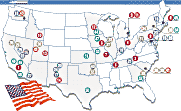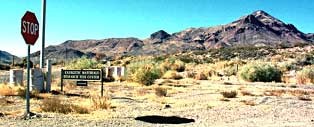
DU top
home
| Facilities related to radioactive depleted
uranium weapons are scattered over virtually
the entire United States. The total number
of facilities for R&D, manufacture, test
firing, storage, and disposal of DU, including
those that have been shut down due to radioactive
contamination, is upwards of 50. They are
far smaller in size and number than the nuclear
weapons facilities spread across the country,
but like the testing ranges and disposal
sites for the latter, they end up in sparsely
populated areas, where they contaminate the
environment and threaten the health of local
residents. The map shows the locations of DU munition facilities on a list compiled by the Army Environmental Policy Institute (AEPI) in 1995. I will report on contamination issues related to these facilities, particularly the firing ranges. [Story and photos by Akira Tashiro]
|
 Click to view larger map (27K) |
 |
 |
|||
| In the foreground lies the Energetic Materials
Research Test Center attached to the New
Mexico Institute of Mining and Technology.
DU rounds were test fired all over the mountain
marked with "M." The closest town
is only about three kilometers away. (Socorro,
New Mexico) Click to view larger picture(37K) |
Pyramid Lake lies downwind of the Sierra
Army Depot, where vast amounts of weapons
have been destroyed for many years. It is
feared that the Paiute Tribe's treasured
fishing ground is contaminated by depleted
uranium and chemical substances. (Paiute
Reservation, Pyramid Lake, Nevada) Click to view larger picture(37K) |
The main purpose of DU shells is to destroy tanks made of heavy metals. Test firing of DU shells from tanks requires a large firing range; aerial bombing practice from airplanes requires huge desert bases.
![]() Changing perceptions of the government
Changing perceptions of the government
The Nelice Air Force Base appears to surround
the Nevada Nuclear Testing Site. It is the
only DU munition firing site in current use
by the Air Force. The base covers 1.25 million
hectares (about 4,830 sq. miles). The Nuclear
Regulatory Commission (NRC) permits DU rounds
to be used on the southeast, or the Las Vegas
side, of the base. Here, 7,900 rounds of
30mm shells are tested each year.
Unfortunately, the permissible area happens to lie entirely within a national desert wildlife preserve. DU rounds have been test-fired here since the early 1970s, because radioactivity and heavy metal pollution were not considered serious problems until the mid 1980s. However, a US Congress decision required the Air Force to find 44,500 hectares (about 170 sq. miles) for a wildlife preserve in another part of the state to compensate for the land it contaminated in this area.
 Grace Potorti (45) =pictured=, executive director of the NGO Rural Alliance
for Military Accountability based in Reno,
Nevada, explains the change in attitude of
the state residents and state government
as follows.
Grace Potorti (45) =pictured=, executive director of the NGO Rural Alliance
for Military Accountability based in Reno,
Nevada, explains the change in attitude of
the state residents and state government
as follows.
"Nevada cooperated with atmospheric nuclear tests at the Nevada Nuclear Testing Site since the beginning of the 1950s. Until the mid-1980s, it welcomed every expansion of military presence. Then things changed. Though the military presence was doing wonders for the economy, the people and the state government began to realize that the damage to the eco-system and the health of the residents from the use of DU and other munitions surpassed the benefits.
![]() 1.5 million unexploded shells
1.5 million unexploded shells
One of these is the Army's Jefferson Proving Ground (JPG) in southeast Indiana. To demonstrate the power and accuracy of DU rounds, test firings were repeatedly carried out over 22,300 hectares (about 85 sq. miles) between the mid-80s to 1994. The legacy is about 70 tons of DU, shell fragments, and contaminated storage buildings.
Since 1941, JPG has been test-firing various other kinds of weaponry as well-about 1.5 million unexploded rounds were simply abandoned there.
![]() Tremendous clean-up costs
Tremendous clean-up costs
Faced with such a mind-boggling figure, the cleanup has bogged down. Until it takes place, wild deer and other animals living in the vicinity of the radiation-contaminated base will absorb depleted uranium through the air and food.
Area residents have long hunted deer for food and pleasure. People who eat that venison will absorb depleted uranium concentrated by the food chain. They can buy safe drinking water, but they cannot escape the dangers of raising cattle, other livestock and crops on contaminated water.
Though the Department of Defense assures the residents that contamination on the base will not affect their health, Potorti says, "People around here are very worried."
Moreover, as seen in communities living near the firing range of the Energetic Materials Research Test Center attached to the New Mexico Institute of Mining and Technology in Socorro, New Mexico, and the Sierra Army Depot in Herlong, California, the historic homes of native American tribes are being contaminated, and health problems are emerging.